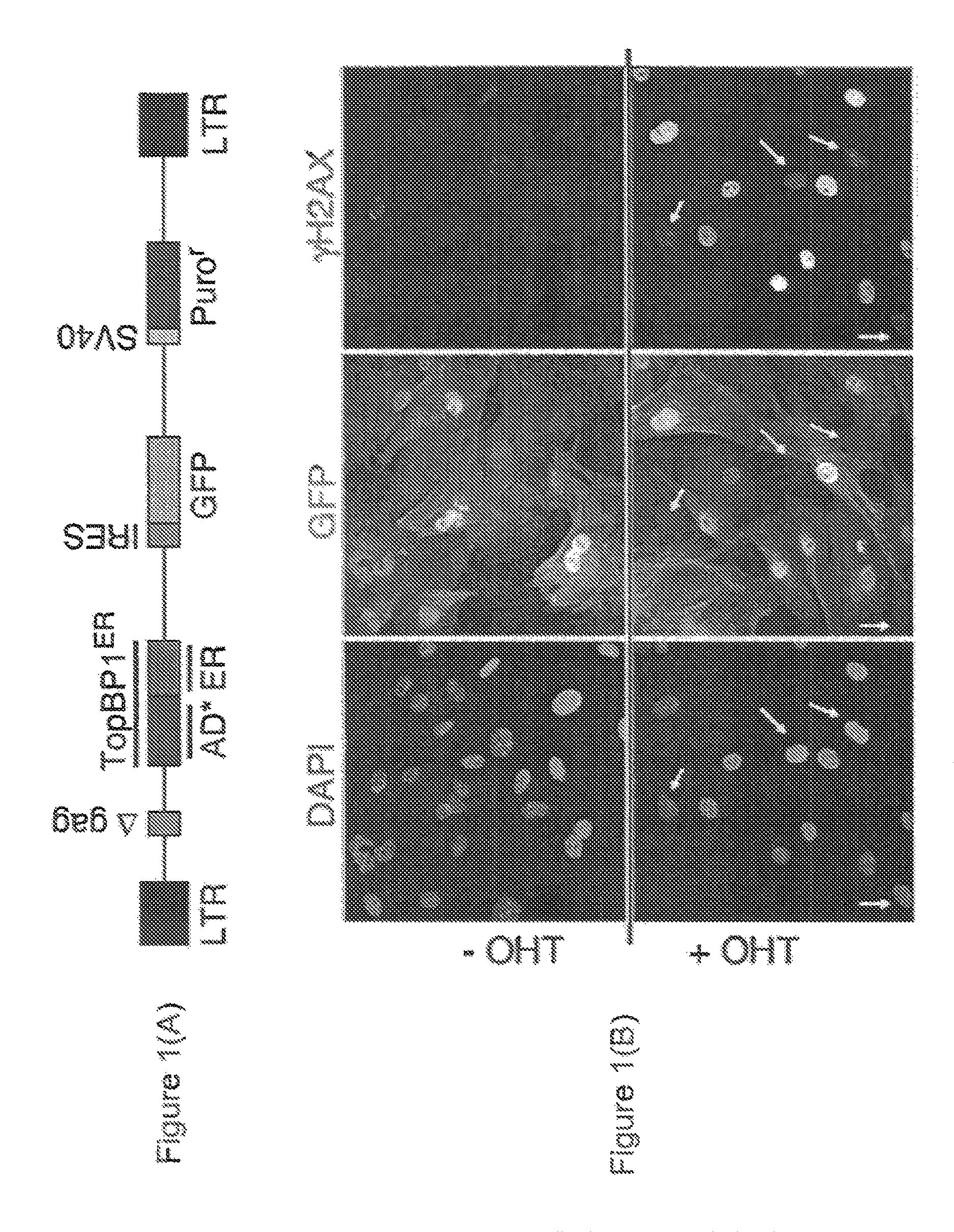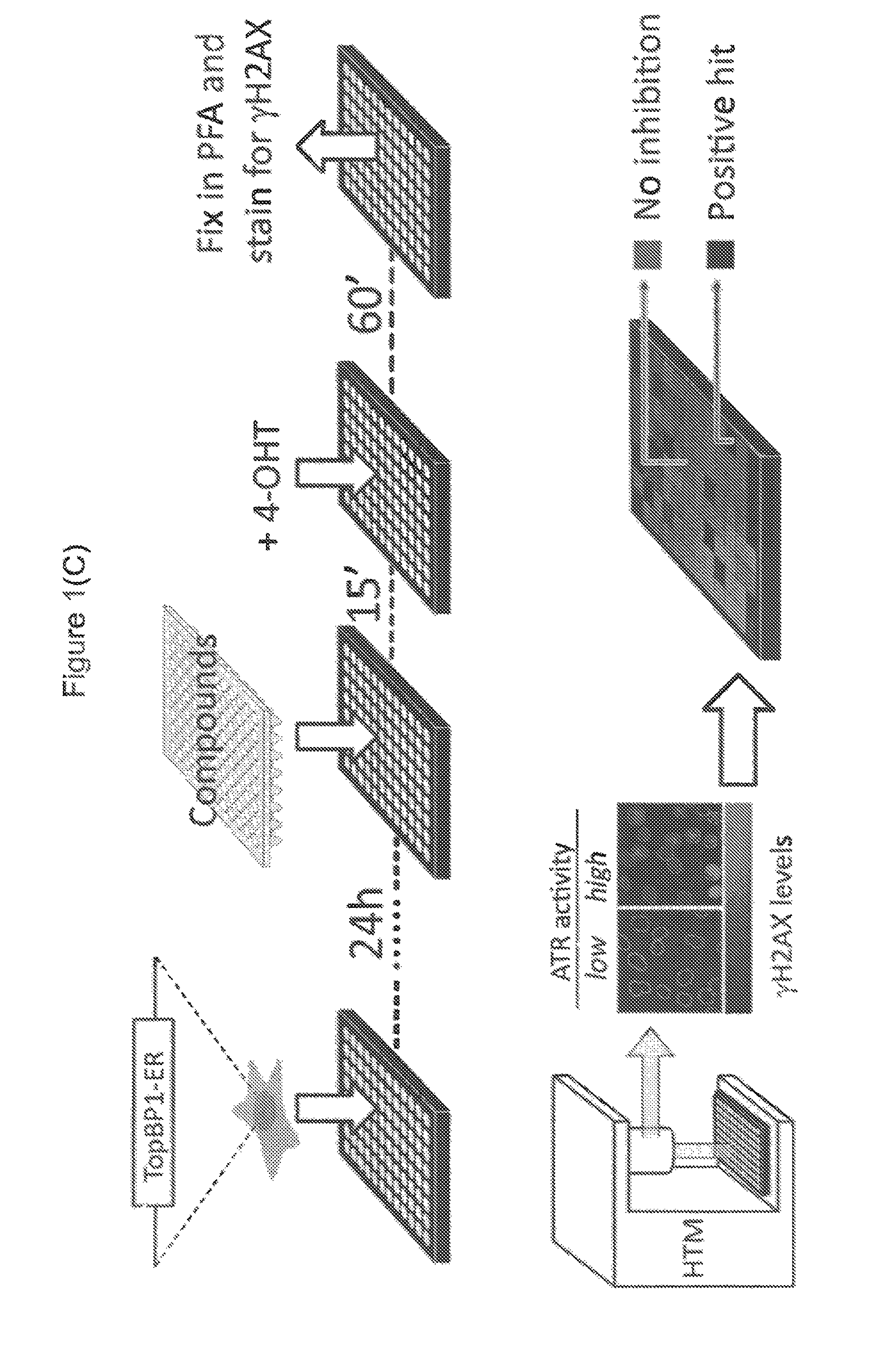Chemical entities
a chemical entity and tricyclic technology, applied in the field of atr inhibitors, can solve the problems of cell cycle arrest, lethal amounts of rs leading to cell death, atr inhibition may be particularly toxic to cells with high levels of rs, etc., and achieve the solubility of chemical entities of formula (i) used in preparation
- Summary
- Abstract
- Description
- Claims
- Application Information
AI Technical Summary
Benefits of technology
Problems solved by technology
Method used
Image
Examples
example 1
[0223]
[0224]A mixture of intermediate X (100 mg, 0.30 mmol) with indole-4-boronic acid pinacol ester (90 mg, 0.37 mmol), dichlorobis(triphenylphosphine)palladium(ii) (40 mg) and a 2M aqueous solution of Na2CO3 (0.4 mL) in dioxane (2 mL), was heated in a high pressure tube for 3 h. The dark mixture was cooled down to rt, diluted with water (20 mL) and extracted with EtOAc (2×15 mL). The organic layers were washed with brine, dried over Na2SO4 and concentrated in vacuo. The crude was purified first by flash column chromatography (Isolute Si II 5 g) eluting with a solvent system of EtOAc / cyclohexane (from 50% to 100% on EtOAc) and then with NH3 7 M in MeOH / DCM (from 0% to 10% on NH3). Required product was recovered as cream solid that was tritured several times with diethylether to obtain 12 mg of Example 1.
[0225]1H NMR (300 MHz, DMSO) δ 7.89 (d, J=7.4 Hz, 1H), 7.44 (d, J=8.0 Hz, 1H), 7.36 (d, J=2.8 Hz, 1H), 7.24 (d, J=2.8 Hz, 1H), 7.11 (t, J=7.8 Hz, 1H), 4.53 (d, J=12.6 Hz, 1H), 4.33 ...
example 2
[0248]
[0249]Example 2 was synthesized following a similar protocol to Example 1 by coupling of intermediate XI with indole-4-boronic acid pinacol ester.
[0250]1H NMR (300 MHz, DMSO) δ 7.88 (d, J=7.4 Hz, 1H), 7.44 (d, J=8.0 Hz, 1H), 7.35 (d, J=3.0 Hz, 1H), 7.24-7.03 (m, 2H), 4.56 (d, J=12.3 Hz, 1H), 4.31 (dd, J=10.8, 3.1 Hz, 1H), 4.00 (d, J=11.3 Hz, 1H), 3.85-3.78 (m, 5H), 3.52-3.58 (m, 1H), 3.31-3.02 (m, 6H), 2.89 (s, 3H) 2.10-2.02 (m, 2H).
[0251]LC-MS1: tR=4.54 min, M+1=471.0
Intermediate XI
[0252]
[0253]To a cooled (0° C.) solution of intermediate IX (75 mg, mmol) in DMF (3 mL) with bis(2-bromoethyl) ether (75 μL, mmol) was added tBuONa (55 mg) in one pot. The resulting mixture was stirred at rt for 5 h. More tBuONa (25 mg) was added stirring at rt for 22 h. The mixture was diluted with EtOAc and water. The organic layer was separated and washed with water (3×10 mL), dried over Na2SO4 and concentrated in vacuo. The crude, intermediate XI (100 mg) was used further into next step without...
example 3
[0254]
[0255]Example 3 was synthesized following a similar protocol to the one used for Example 1 by coupling of intermediate XII with indole-4-boronic acid pinacol ester.
[0256]1H NMR (300 MHz, DMSO) δ 11.14 (s, 1H), 7.87 (d, J=7.5 Hz, 1H), 7.44 (d, J=7.5 Hz, 1H), 7.42 (bs, 1H), 7.23 (bs, 1H), 7.16 (d, t=7.8 Hz, 1H), 4.55 (d, J=12.9 Hz, 1H), 4.31 (dd, J=10.7, 3.2 Hz, 1H), 4.00 (d, J=11.2 Hz, 1H), 3.93-3.62 (m, 5H), 3.51 (t, J=10.6 Hz, 1H), 3.23-3.05 (m, 5H), 2.79 (s, 3H), 2.11-2.05 (m, 2H).
[0257]LC-MS1: tR=4.55 min, M+1=471.0.
[0258][α]D=+40 (c 0.273, CHCl3 / MeOH 9:1).
Intermediate XII
[0259]Intermediate XII was synthesized following a similar synthetic protocol than the one used for the synthesis of intermediate XI, but using in step 1, 3(R)-hydroxymethylmorpholine hydrochloride. Intermediate XIV, [α]D=+29 (c 0.52, CHCl3 / MeOH 9:1).
PUM
 Login to View More
Login to View More Abstract
Description
Claims
Application Information
 Login to View More
Login to View More - R&D
- Intellectual Property
- Life Sciences
- Materials
- Tech Scout
- Unparalleled Data Quality
- Higher Quality Content
- 60% Fewer Hallucinations
Browse by: Latest US Patents, China's latest patents, Technical Efficacy Thesaurus, Application Domain, Technology Topic, Popular Technical Reports.
© 2025 PatSnap. All rights reserved.Legal|Privacy policy|Modern Slavery Act Transparency Statement|Sitemap|About US| Contact US: help@patsnap.com



